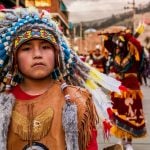Ancient America: The Buffalo Hunt

At the beginning of the European invasion of North America, there may have been as many as 75 million buffalo on the Great Plains. For thousands of years, the buffalo had been the walking supermarket of the Plains Indian people, providing them with food, clothing, tools, toys, and shelter. For most of the year, the buffalo provided the Plains Indians with most of their food, with durable hides for making tipi covers and blankets, and strong bones for making a wide variety of tools-at least 87 different tools according to one study. For the Plains Indians, hunting was not a choice, but a way of life, a strategy for survival.

Technically, the animal is a bison, but it is commonly called a buffalo, particularly by Indian people. At the present time, there are two subspecies of bison in North America: plains bison (Bison bison bison) and wood bison (Bison bison athabascae). Over the past 10,000 years, the North American bison have been gradually decreasing in size. The now extinct Bison latifrons had an overall horn spread (including horn sheaths) in excess of two metres (more than six feet) as compared with about three-fourths of a metre for today’s bison. Bison at the end of the ice ages 12,000 years ago were about 25% larger than the modern animals.



Shown above are skulls from Bison latifrons.
In hunting buffalo over the past 12,000 years or so, Indian people gained a great deal of knowledge about the animal, its habits, and its environments. Despite its massive size, the buffalo is amazingly fast: over short distances it can reach speeds of 50 kph (30 mph). They also have tremendous endurance and can run at slower speeds for extended periods of time. Archaeologist Jack Brink, in Imagining Head-Smashed-In: Aboriginal Buffalo Hunting on the Northern Plains, notes:
“They can turn on a dime, twirling with their heads down and horns out. Many a coyote, wolf, and human hunter have been bore and flung through the air by a buffalo that just a moment before had been standing still.”
For the Indian hunters, the thing that made one buffalo better than another was the amount of fat that the animal had. Thus, hunters were able to pick out the fattest animals in the herd by looking at their curves and the sheen of their coats. They also knew which animals would be fat at any given time of year. Maximizing fat meant that Indian hunters harvested cows for much of the year. Only in the summer would bulls be a preferred target.
Indians hunted buffalo in many different ways, ranging from communal hunts in which many different groups would come together to harvest a hundred animals at a single time using a buffalo jump or a pound, to solitary hunting in which only a few animals would be taken.
Indian people managed the environment to enhance the herds and to position them. Long ago Indian people had learned that if the grasslands were burned off, then it would come back greener and more nutritious as the burned grass provided fertilizer to the soil. They knew that the buffalo were attracted to these greener, freshly burned areas. In the fall and in the spring, fires would be intentionally lit so that the buffalo would be attracted into these areas.
The Buffalo Jump:

One of the ways Indian people hunted buffalo was to drive them over a cliff. Scattered across the Northern Plains are thousands of these buffalo jump sites. Many of them were used only once, while others were used repeatedly.
Buffalo jumps were communal kill sites in that many groups of Indian people had to come together and work cooperatively to make the site work. This communal hunting brought together people who did not normally live together as one group. During most of the year, the people lived in small bands of 50-70 people. For the buffalo jump, several hundred people (sometimes more than a thousand) would come together. Archaeologist Jack Brink writes:
“Not only were buffalo jumps an extraordinary amount of work; they were the culmination of thousands of years of shared and passed-on tribal knowledge of the environment, the lay of the land, and the behavior and biology of the buffalo.”

The first problem in using a buffalo jump is that the buffalo herd is usually not close to the kill area. The herd must be lured over a distance of many miles to the cliff.
To help lure the herd, a young man would dress up like a buffalo calf. He would then approach the herd, mimicking calf behavior. He would have to make the calls of a buffalo calf-not just any calls, but those made by a calf in distress. Other young men, dressed as wolves and mimicking their behavior, would appear in the prairie behind the herd and create an illusion of danger. Slowly and patiently these buffalo runners would lead the herd toward the kill site. Being a buffalo runner was a hazardous occupation and many were killed or maimed.

The painting of a buffalo runner shown above is on display at the First Peoples Buffalo Jump in Ulm, Montana.
Stretching back for many miles into the prairies behind the cliff are the drive lines which will guide their herd. These are marked with stone cairns which can be used as a base for wedging in the ends of sticks and brush. This helps create the illusion, from the perspective of the buffalo’s poor eyesight, of a wall or barrier.

In the drawing above, the dotted lines show the drive lines for the Head-Smashed-In and Calderwood buffalo jumps.

The drawing above, from the Head-Smashed-In Buffalo Jump Interpretive Centre, shows the drive line cairns being prepared for a buffalo hunt.
The Pound:

The buffalo pound was a way of harvesting large numbers of bison in a similar fashion to the buffalo jump. However, the final kill location was not a cliff, but rather a pound or corral made of wood. Pounds were located in the lightly wooded areas that surround portions of the Great Plains. Here the hunters could find enough wood to build the pound. Using techniques similar to those used in the buffalo jump, the herd would be lured over many miles and then driven into the pound where they would be killed with bows and arrows and spears as they milled around.

Pound is from an archaic English term for enclosure.
The wooden structure of the pound was actually somewhat flimsy by modern standards. The walls were draped with bison hides, the darker sides facing in, creating the illusion of a solid surrounding wall. Once in the corral, the animals saw only solid darkness surrounding them and no visible escape. Thus they simply circled in the confines of a structure which they could have easily destroyed.
Hunting on Foot:

During much of the year, Indian people would hunt buffalo in small groups or alone. A solitary hunter might use a disguise to get close to the herd and take an animal or two. Small groups of hunters from the same band might take five or ten animals. The camp would then move to the kill site to process the carcasses rather than transport them back to camp.

In the winter, hunters wearing snowshoes would drive the buffalo into snow banks where the animals would become mired down and thus could be easily killed. At other times they waited at watering holes where the buffalo would become less mobile because of the mud. Sometimes they would set ambushes along the well-used buffalo trails or hunt them as they swam across rivers and lakes.





